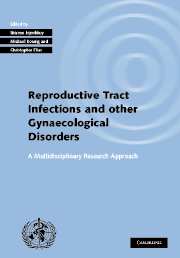 Investigating Reproductive Tract Infections and Other Gynaecological Disorders
Investigating Reproductive Tract Infections and Other Gynaecological Disorders Published online by Cambridge University Press: 07 December 2009
This chapter addresses design issues in the measurement of gynaecological morbidity. Recognizing that gynaecological morbidity is a complex phenomenon, the possible study designs are reviewed and their shortcomings and strengths are highlighted. Finally, I shall focus on community-based studies as they provide a holistic view of gynaecological morbidity from various perspectives.
In considering designs for the measurement of gynaecological morbidity, three questions need to be asked: Why are we concerned with measuring gynaecological morbidity (or, what is our aim)?; Who is our target population?; What concepts are we trying to measure?
The aims of measuring gynaecological morbidity are, in my view, to establish the prevalence of morbidity conditions, and to understand perspectives, behaviours and experiences, as well as determinants, for the purpose of guiding policies and programmes aimed at reducing reproductive morbidity. Interventions can then be designed, on the basis of such studies, to reduce the burden of gynaecological morbidity. Accurate measurement of morbidity is required, in turn, to evaluate these interventions.
In focusing on women's reproductive health, and specifically on the component of gynaecological morbidity, the target population is not only women in the reproductive ages. Adolescents in preparation for healthy sexuality and reproduction, and women past reproduction still sexually active or not and experiencing the consequences of reproduction, are part of the target population. In addition, women's reproductive health cannot be separated from men's health and behaviours, particularly in terms of such concerns as sexually transmitted infection (STI), contraception and psychological well-being, all relevant to the concept of reproductive morbidity.
To save this book to your Kindle, first ensure [email protected] is added to your Approved Personal Document E-mail List under your Personal Document Settings on the Manage Your Content and Devices page of your Amazon account. Then enter the ‘name’ part of your Kindle email address below. Find out more about saving to your Kindle.
Note you can select to save to either the @free.kindle.com or @kindle.com variations. ‘@free.kindle.com’ emails are free but can only be saved to your device when it is connected to wi-fi. ‘@kindle.com’ emails can be delivered even when you are not connected to wi-fi, but note that service fees apply.
Find out more about the Kindle Personal Document Service.
To save content items to your account, please confirm that you agree to abide by our usage policies. If this is the first time you use this feature, you will be asked to authorise Cambridge Core to connect with your account. Find out more about saving content to Dropbox.
To save content items to your account, please confirm that you agree to abide by our usage policies. If this is the first time you use this feature, you will be asked to authorise Cambridge Core to connect with your account. Find out more about saving content to Google Drive.